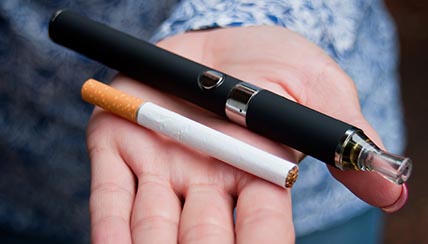Vaping and Teens: What You Need to Know Before School Starts
“Dragon Banana Berry.” “Fuji Apple Strawberry Nectarine.” “Unicorn Milk.”
These are real vape juice flavor labels. Sweet and whimsical, they would be right at home in a snow cone stand. It seems odd that you would have to be over 21 to purchase something called “Unicorn Milk,” for instance, but that’s one of the things that have made vapes, or e-cigarettes, so controversial.

“If you look at the marketing around e-cigarettes, a lot of it features young people using them, having fun with them, going to parties with them,” said Thomas Ylioja, PhD, a tobacco cessation expert at National Jewish Health. “The advertising was very clearly directed at young people, and young people are very susceptible to marketing for substances, including nicotine, alcohol and other types of drugs.”
In 2019, prior to the pandemic and remote learning, 27.5% of high school students reported using e-cigarettes. However, by 2021, the popularity of vaping among high school teens waned to 11.3%. This decline might signal progress. But many of these teens spent 2020 and 2021 learning remotely. They were often under the watchful eye of their parents at home.
The new school year promises a return to some level of normalcy. It’s possible that teens out of the home will again be influenced by the appeal of vaping. However, experts like Dr. Ylioja have made it their mission to educate parents and teens and stem the tide of new vape users.
Vapes vs. Cigarettes: A Cloud of Unknowns
 Instead of burning tobacco, vapes use a battery to heat a liquid mixture (also called “e-liquid”) into a nicotine-filled aerosol. As discussed, this nicotine vapor can come in a variety of flavors, many of which are sweet and dessert-themed (there’s even a deep-fried ice cream flavor).
Instead of burning tobacco, vapes use a battery to heat a liquid mixture (also called “e-liquid”) into a nicotine-filled aerosol. As discussed, this nicotine vapor can come in a variety of flavors, many of which are sweet and dessert-themed (there’s even a deep-fried ice cream flavor).
Nicotine on its own is highly addictive and associated with health risks like high blood pressure. Studies have also shown that early nicotine addiction can impair brain development, decreasing attention span, learning ability and impulse control. However, nicotine vapes were originally hailed as smoking alternatives because they appeared to lack many of the cancer-causing agents in tobacco products. It also was believed that vapes could be used as a tool to curb conventional smoking. According to Dr. Ylioja though, some of this early cheerleading may have been a case of speaking too soon.
With research into the long-term effects of vaping just beginning, what do we know so far about the consequences of e-cigarette vapor? “Well, the truth is, not a lot,” said Dr. Ylioja. “And that's one of the scariest aspects of e-cigarettes — that people who are using them are really going to be guinea pigs for tobacco industry-funded tech groups. So their motivation is not to help people with quitting smoking. Their motivation is to keep them addicted to nicotine and have them try their device in preparation for other products that they might use.”
It took Americans decades to come to terms with the impacts of cigarettes, but today’s experts are better positioned than 1950s physicians in signaling the long-term dangers of certain substances. Along with nicotine, vaping products can contain lung-damaging heavy metals and chemicals such as acrolein, propylene glycol, diacetyl and benzene, among others. Diacetyl alone is known to cause “popcorn lung” disease, a deadly condition.
In other words, we already know enough about vapes to conclude there’s a danger. And, for those who decide to wait for a bigger smoking gun, it may be too late.
How Vaping Appeals to Younger Users
“E-cigarettes are tailor-made for young people,” according to Dr. Ylioja. “They're gadgets. They're fun. They're electronic. You can do tricks with them when you're exhaling.”
For evidence of vaping’s youth appeal, look no further than social media influencers. For example, twenty-seven year old vaping influencer Austin Lawrence amassed a following of over 2.4 million users on Instagram alone. His content would often highlight his various vape tricks in different locations. Facebook and Instagram banned the explicit promotion of vaping products in 2019. However, it appears that companies have found new ways to pitch their products to younger demographics.
For instance, some vaping companies on TikTok are promoting their use of “discreet packaging” for mailed products. Ordered items will arrive in plain white boxes and abbreviated versions of company names appearing on credit card statements. This practice has caused many to accuse companies of encouraging underage kids to buy vaping products on the sly.
“The industry is ultimately responsible for the epidemic of youth vaping,” Dr. Ylioja lamented, “because they've specifically targeted young people with their products, knowing they’re addictive.”
Vaping in School
The first generation of vaping devices from the 2000s, called “cig-a-likes,” resembled their paper predecessors. However, as the industry boomed, vapes began to take a less familiar and more concealable shape. There are now vapes on the market, such as pod mods, that look more like common flash drives. Naturally, this makes them difficult to detect at school, perhaps by design.
“They're easy to hide,” said Dr. Ylioja. “And parents and teachers are not familiar with these devices, so they don't recognize them. When young people are using them, they look like flash drives, they look like pens, they look like markers, they look like watches.”
Furthermore, because the cloud from vapes dissipates so quickly, teens can hide their habits at school by “ghosting.” This practice involves holding vape aerosol in the lungs so long that nothing comes out.
As the majority of students return to in-person learning, where peer pressure becomes more of a factor, it’s important for parents to understand enough about vaping to communicate effectively with their teens.
How to Talk to Your Teen About Vaping
 This is a very delicate topic to approach with a teenager, as teens are often rebellious by nature and could buck against hardline commands. This is why experts like Dr. Ylioja advocate for a more conversational approach.
This is a very delicate topic to approach with a teenager, as teens are often rebellious by nature and could buck against hardline commands. This is why experts like Dr. Ylioja advocate for a more conversational approach.
“Ask them what they know about it. What do you know about vaping? What do you know about what have you seen? What have you experienced?” Dr. Ylioja advised. “And leave that conversation really open because you want to make sure that somebody is being honest with you.”
If your teen admits to vaping, it’s important to be understanding. As discussed, this is a very attractive trend. “It's really important to keep those emotional reactions in check, and it's important to keep the conversation fact-based,” Dr. Ylioja said. “If you don't know something, don't make up a story because youth have so much access to information. If they perceive that you're giving them incorrect information, they're not going to believe you're credible and they're not going to listen to what you have to say anymore. It's really important that parents listen and not lecture.”
Final Thoughts
As more research is published on long-term effects of vaping, we should have a clearer picture of the risks of teen vaping. For now, it’s important that parents and teens have access to guidance. If your teen is struggling with vaping, consider using My Life, My Quit ™ — a free helpline that can offer support and accurate information regarding vaping and tobacco.
This information has been reviewed and approved by Thomas Ylioja, PhD (July 2022).
